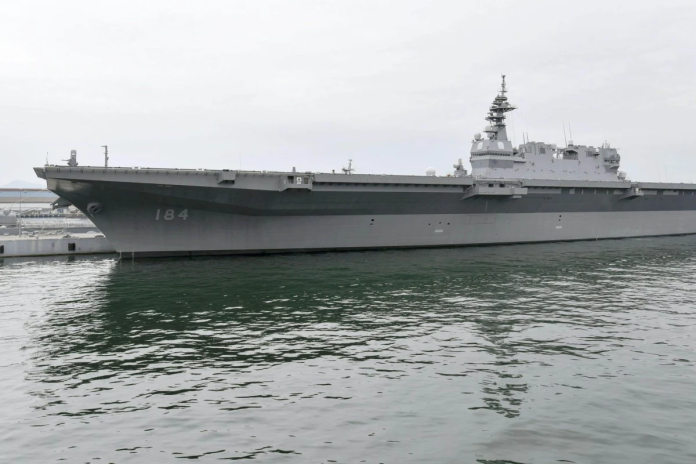- The name of the ship has already been criticised in China because it shares its name with an imperial warship that bombed Shanghai in the 1930s
- The helicopter carrier has been upgraded to carry F-35B fighters, making it Japan’s first aircraft carrier since the Second World War
Japan’s upgrading of a warship to become its first aircraft carrier since the Second World War has been criticised in China, raising questions about whether it violates the country’s post-war pacifist constitution.
The name of the newly upgraded Kaga has previously been criticised because a former ship with the same name was involved in the bombing of Shanghai and Tokyo’s motives for upgrading the ship have also been questioned.
After the ship was converted to an aircraft carrier, Chinese foreign ministry spokeswoman Hua Chunying said Japan should “adhere to its defence-only policy” and be cautious in military development, “not the other way around”.
The Kaga entered service in 2017 as a helicopter carrier, but has now been upgraded to carry Lockheed Martin F-35B Lightning II stealth fighters.
The ship will undergo a second round of modifications to its hull in 2026-27 to help support its role as a carrier of fixed-wing warplanes.
Kaga’s sistership Izumo, commissioned in 2015, will also be modified in a process expected to finish in 2027. The two ships were commissioned as helicopter carriers that could be upgraded to carry fixed-wing fighters if needed.
After the upgrade, both ships will be able to carry 12 fighters and 16 helicopters. The Japanese government had already ordered 42 F-35Bs for the carriers, although it has not explained why it wants more planes than its current navy can carry.
China believes that the modification of the Izumo-class carrier violates Japan’s “Peace Constitution”, which does not allow Japan to possess offensive weapons, arguing that carriers can be used to strike targets on foreign soil.
Hua, from the Chinese foreign ministry, said the clause in the Japanese constitution – which renounces the right to wage wars – “is an important legal guarantee and symbol of Japan’s post-war path towards peaceful development, and a solemn commitment by Japan to the international community”.
Tokyo says its position remains unchanged, and the modified carriers are the minimum necessary for self-defence.
The government says F-35B fighter jets will not be deployed full-time on the Kaga and Izumo, so they will not be considered attack aircraft carriers, which are banned under Japan’s constitution, according to national broadcaster NHK.
When the upgrade plan was first made public in 2018, the then defence minister Takeshi Iwaya said that “the Izumo was originally designed as a multipurpose escort ship, so it wouldn’t pose any threat to other countries if fighter jets are deployed on it.”
Yoichiro Sato, professor in international relations at Ritsumeikan Asia-Pacific University in Japan, said the new carrier had only half the number of fighters China’s first carrier, the Liaoning, holds, adding: “It is more useful as an anti-submarine warfare platform carrying some helicopters as it originally was designated.”
China already has three active aircraft carriers, Liaoning, Shandong and Fujian – all of which are larger than the Japanese carrier – and a fourth one is being built.
Song Zhongping, a former Chinese military instructor, said the Japanese carrier’s fifth generation F-35B fighters were more advanced than the J-15s on China’s carriers, but their limited numbers would reduce their effectiveness.
“The modification of Kaga is more like a technical verification test case for Japan’s next generation of even larger vessels,” he said.
National Defence News, an official publication of China’s People’s Liberation Army, has also questioned the effectiveness of the Japanese carriers, saying their flight decks cannot be used by fixed-wing early warning aircraft.
“This means that it is difficult for this class of ship to operate independently outside a larger battle group, and its ability to fight independently is limited,” it said.
Even the name of the Kaga has caused controversy. Kaga was an ancient province that forms part of the modern-day Ishikawa prefecture on Honshu, but the name was previously used for a carrier that took part in the invasion of China in the 1930s.
Planes launched from the 1930s carrier took part in a major air raid in Shanghai and the attack on Pearl Harbor in 1941. The ship was eventually sunk by the United States in the Battle of Midway.
In 2017, when the ship was first commissioned, Wu Qian, a spokesman for China’s defence ministry, criticised the name saying the previous Kaga was “one of the main warships of the Japanese militarists during the aggression against China” and warned that the “ghost of Japanese militarism” might return.
“I don’t understand why the Japanese always prefer to use the names that were used by the Japanese army in World War Two,” Wu said.
“Is it because they do not want to make a clear break with the history of militarism, or are they deliberately provocative to hurt the feelings of the people of the countries that were victims of World War Two?”
Sato said that although many modern Japanese ships share their names with those from the imperial era, they tend to be named after places and natural features which have particular importance in the Shinto religion rather than individual commanders.
For example, he said Izumo is the site of an important shrine and making accusations about such place names is an exercise in “far-fetched imagination about Japanese nationalism.”







































